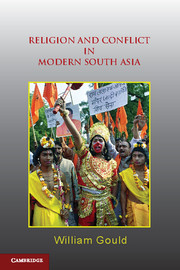Book contents
- Frontmatter
- Contents
- Abbreviations
- Glossary
- Acknowledgements
- 1 Introduction
- 2 Building Spheres of Community
- 3 Transforming Spheres of Community
- 4 Defining Spheres of Community
- 5 State Transformation, Democracy and Conflict
- 6 Forging National Consensus and Containing Pluralism
- 7 New Conflicts and Old Rivalries
- 8 The Resurgence of Communalism?
- Conclusion
- Bibliography
- Index
- References
4 - Defining Spheres of Community
Society, Religious Mobilisation and Anti-colonialism
Published online by Cambridge University Press: 05 June 2012
- Frontmatter
- Contents
- Abbreviations
- Glossary
- Acknowledgements
- 1 Introduction
- 2 Building Spheres of Community
- 3 Transforming Spheres of Community
- 4 Defining Spheres of Community
- 5 State Transformation, Democracy and Conflict
- 6 Forging National Consensus and Containing Pluralism
- 7 New Conflicts and Old Rivalries
- 8 The Resurgence of Communalism?
- Conclusion
- Bibliography
- Index
- References
Summary
As well as being an era of great political change, the 1920s and 1930s was also a time of urbanisation, steady development of industrial activity and changes in the social lives of Indian workers and peasants. The great industrial city of Kanpur, for example, in the United Provinces (Uttar Pradesh) in the interwar period, became one of the key centres in north India for rural–urban migration to cotton mill and factory work. Here, immediately following the Great War, three new mills were set up. The slump did not create serious setbacks in this steady growth, and in the period of 1930–7, the total number of millworkers in the city increased by 31.2%. The bastis and neighbourhoods of the city were largely organised around caste and religious community differences – a situation that was enhanced as a wider array of peasant communities made their way to the city.
These (largely) male sojourners sought the proximity of caste and community fellows as a means of mediating and surviving the often unfamiliar urban environment. The struggle for employment in the mills also strengthened many of these bonds. This was partly about ritual distance: in the Elgin Mill, many Brahman workers would not eat in the dining shed for fear of ritual pollution by other castes or Muslims. Mistris or jobbers – the fixers of recruitment into the mills and factories – generally worked in the favour of their own communities too. This enabled control over particular groups of workers, so community affinity became a dynamic of social authority, as well as association, with the mistri often accepting dasturi (a bribe) for work. The existence of reserve (termed as badli) workers was also a dynamic of this relationship, and a fact that made it difficult for those in employment to bargain for better conditions and wages for most of the interwar period. However, community and caste association was not just a means of maintaining social dominance, but also provided the basis of opposition to overbearing bosses and mistris. Kanpur’s workers, in many cases, used the politics of Hindu mobilisation to assert higher status in the urban environment. Religious community and caste, then, interacted in complex ways with other kinds of class and occupational identities when we look at this level of politics, and it is this theme that will form the central focus of this chapter.
- Type
- Chapter
- Information
- Religion and Conflict in Modern South Asia , pp. 119 - 162Publisher: Cambridge University PressPrint publication year: 2011



